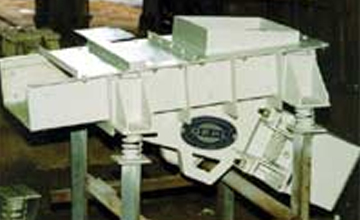Electro Magnetic Vibrating Feeders
Orton Make Electromagnetic Vibratory Feeders are equipped with electromagnetic drives which generate vibrations required for conveying of material. The electromagnetic drives are robust in construction with very
high reliability factor. These conveyors come with a specially designed controller required for operation of the electromagnetic conveyor. These controllers convert the input AC supply voltage into pulsating DC output
which results in generation of vibrations. A thyristor such as a silicon controlled rectifier is used for this purpose. The fringe angle of the SCR can be varied sleeplessly using a potentiometer or an analogous electrical signal / PLC signal from an external command variable unit, which in turn increases / decreases the amplitude of vibrations thereby controlling the output of the conveyor as required.
As in the case of electromechanical feeders depending on the material conveyed, the conveyors can be supplied on two types viz, through type and tubular type. Suitable liners in case of through conveyors are provided where severely abrasive materials are handled as in the case of electromechanical conveyors.
Advantages of Electro Magnetic Vibrating Feeders:
- Electromagnetic feeders allow highly accurate and variable feeding rates, which is ideal for process control in batching and mixing operations.
- They consume less power compared to motorized feeders, making them cost-effective for continuous operations.
- Electromagnetic feeders can start or stop instantly without any mechanical delays, enhancing operational efficiency.
- With no rotating parts, they require minimal maintenance, reducing downtime and maintenance costs.
- Their compact and lightweight construction allows for easy installation in limited space environments.
- The absence of mechanical wear parts minimizes contamination, making them suitable for food, pharmaceutical, and chemical industries.
- These feeders operate quietly, creating a better working environment, especially in noise-sensitive areas.
- They ensure uniform and steady flow of bulk materials, improving downstream process performance.
- Suitable for fine powders to large lumps, making them versatile for industries like mining, packaging, food processing, and recycling.
- They can be integrated with PLCs and automation systems for remote control and process optimization.
Application Industries of Electro Magnetic Vibrating Feeders :
Electro Magnetic Vibrating Feeders are widely used across various industries for controlled material feeding,dosing, or conveying. Their ability to precisely control feed rate makes them essential in the following industries:
- Mining and Mineral Processing : Feeding ores, coal, and aggregates to crushers or screening machines. Handling abrasive materials in mineral processing plants.
- Food and Beverage Industry : Metering dry food products like grains, spices, or sugar. Controlled feeding for packaging or mixing processes.
- Cement Industry : Feeding raw materials like limestone, gypsum, and additives into grinders or kilns.Controlling material flow in batching operations.
- Pharmaceutical Industry : Precise dosing and feeding of powders and tablets. Ensuring contamination-free material flow.
- Chemical Industry : Feeding powders, granules, and chemicals into processing units. Used for accurate batching and dosing. Handling corrosive and hazardous substances safely.
- Fertilizer Industry : Handling urea, phosphates, and potash in granulated or powdered form. Maintaining consistent flow for blending and packaging.
- Ceramics and Glass Industry : Feeding raw materials like silica, feldspar, or clay. Maintaining uniform feed rate to furnaces and kilns.
- Recycling and Waste Management : Feeding shredded plastic, metal, or electronic waste. Assists in separating and processing recyclables.
- Steel and Metallurgical Industry : Feeding sinter, scrap metal, or fluxes into furnaces. Managing materials at high temperatures. Used in smelters, blast furnaces, and rolling mills.
- Packaging Industry : Precise vibration-controlled feeding into filling machines. Enhances speed and
accuracy in automated packaging lines.



